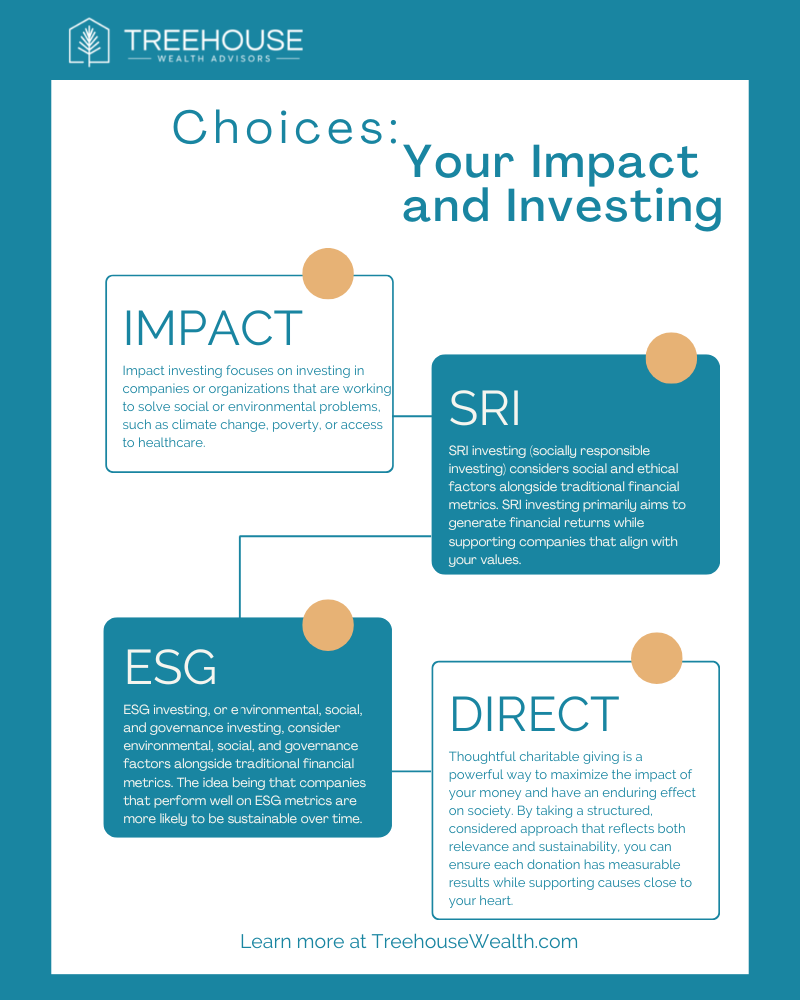
Investing with Influence: What’s the Fuss All About?
- March 9, 2023
Share this article
Investing in your values can be a powerful way to align your financial goals with your personal beliefs. However, when impact supersedes a long-term balanced strategy, it can also cause a balanced portfolio to, well, get off balance. With all the talk of impact investing, ESG investing, and SRI investing, there are now more options than ever for investors who want to make a positive difference in the world through investing. However, since there are still questions to be answered about the “long-term,” we thought it important to break down what these strategies mean and help you better understand how each could influence your investment decisions and results overall. The question to ask is if investing for impact is the best approach or if are there other ways to make an impact in your local or global community that have a more meaningful effect.
Impact Investing
Let’s start with impact investing. Impact investing is a form of investing that aims to generate a measurable social or environmental impact in addition to financial returns. Impact investing focuses on investing in companies or organizations that are working to solve social or environmental problems, such as climate change, poverty, or access to healthcare. Impact investors evaluate the potential impact of their investments using a variety of metrics, such as the number of people reached, or the number of carbon emissions reduced.
Impact investing is different from traditional philanthropy in that it is not just about giving money away but about investing in organizations that are creating positive change. It can also offer the potential for financial returns and has become increasingly popular in recent years as more and more investors seek to align their investments with their values. According to the Global Impact Investing Network (GIIN), the impact investing market was worth $1.164 trillion in 2022. This represents a significant increase from just a few years earlier when the market was valued at $502 billion in 2019. An important question to ask is whether this is the right tool for you and your family to have an impact.
ESG Investing
ESG investing considers environmental “E”, social “S”, and governance ”G” factors alongside traditional financial metrics. The idea behind ESG investing is that companies that perform well on ESG metrics are more likely to be sustainable over the long term and may offer better returns for investors. ESG factors include, but are not limited to, a company’s carbon footprint, labor practices, board diversity, and executive compensation. ESG investors evaluate these factors using various tools and metrics, such as the MSCI ESG Ratings or the Sustainability Accounting Standards Board.
ESG investing is becoming more popular among investors who want to align their investments with their values and achieve financial returns. In fact, many large institutional investors, such as pension funds and endowments, are now incorporating ESG factors into their investment strategies. One reason for the growing popularity of ESG investing is the increasing awareness of environmental and social issues. Many investors are now concerned about climate change, social inequality, and other issues and want to invest in companies working to address these problems. If ESG funds are an option in the retirement plan benefits offered by your employer, remember that choosing a fund to invest in requires a full review of your current financial picture to ensure that your time horizon, risk tolerance, and personal financial goals are considered.
SRI Investing
SRI investing, which stands for socially responsible investing, is a form of investing that considers social and ethical factors alongside traditional financial metrics. SRI investing primarily aims to generate financial returns while supporting companies that align with your values. To achieve this goal, SRI investors typically use a process called screening to identify and avoid companies that do not meet their social and ethical criteria. Screening can take two forms: negative and positive screening.
Negative screening, also often referred to as divesting, involves avoiding companies that engage in controversial industries or activities such as tobacco, alcohol, or weapons. This approach allows investors to align their investments with their values by avoiding companies that do not align with their beliefs.
On the other hand, positive screening involves investing in companies that are positively impacting the world. Positive screening may involve investing in companies that promote sustainability, diversity, and social justice, among other factors.
According to a report by the US SIF Foundation, the total assets under management using SRI strategies have grown to reach $8.41 trillion in 2022. However, SRI investing is not without its challenges. One common criticism of SRI investing is that it may limit investment opportunities and potentially lead to lower returns. Since SRI investors screen out certain companies, they may miss out on profitable investment opportunities.
In summary, investing in alignment with your values can be a powerful way to impact the world positively. Each of the three investment approaches we discussed has unique benefits and considerations. Impact investing allows investors to invest directly in organizations that solve social and environmental problems. ESG investing provides an opportunity to consider sustainability and ethical practices while still achieving financial returns. SRI investing enables investors to avoid companies that do not align with their values and invest in those that do.
Ultimately, choosing any of these approaches will depend on your values, overall financial and community-oriented goals, risk tolerance, and time horizon. It’s essential to do your research and discuss your desired outcomes with a financial advisor. This will help to determine the best investment approach for you and whether these types of investments make sense for you and your family. Often, thoughtful charitable giving is a powerful way to maximize the impact of your money and have an enduring effect on society. Some select to take a structured, approach that reflects both relevance and sustainability. By taking this direct approach you can ensure each donation has measurable results while supporting causes close to your heart and empower yourself with targeted donations crafted for maximum long-term effects.
Need help aligning your money with your values, Treehouse Wealth Advisors are here to listen.
Subscribe To Our Newsletter
Garrison Point Advisors, LLC doing business as “Treehouse Wealth Advisors” (“TWA”) is an investment advisor in Walnut Creek, CA registered with the Securities and Exchange Commission (“SEC”). Registration of an investment advisor does not imply any specific level of skill or training and does not constitute an endorsement of the firm by the Commission. TWA only transacts business in states in which it is properly registered or is excluded or exempted from registration. A copy of TWA’s current written disclosure brochures, Form ADV Part 1 and Part 2A, filed with the SEC which discusses among other things, TWA’s business practices, services, and fees, is available through the SEC’s website at: www.adviserinfo.sec.gov.
Certain hyperlinks or referenced websites, if any, are for your convenience and forward you to third parties’ websites, which generally are recognized by their top-level domain name. Any descriptions of, references to, or links to other products, publications or services does not constitute an endorsement, authorization, sponsorship by or affiliation with TWA with respect to any linked site or its sponsor, unless expressly stated by TWA. Any such information, products or sites have not necessarily been reviewed by TWA and are provided or maintained by third parties over whom TWA exercises no control. TWA expressly disclaims any responsibility for the content, the accuracy of the information, and/or quality of products or services provided by or advertised on these third-party sites.


